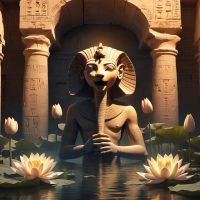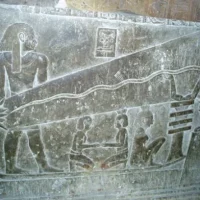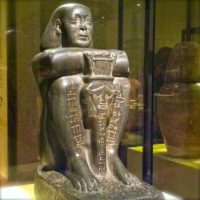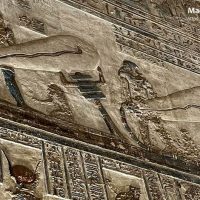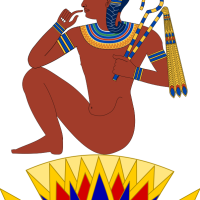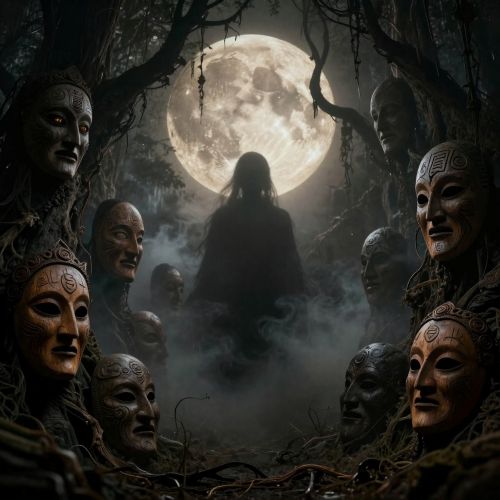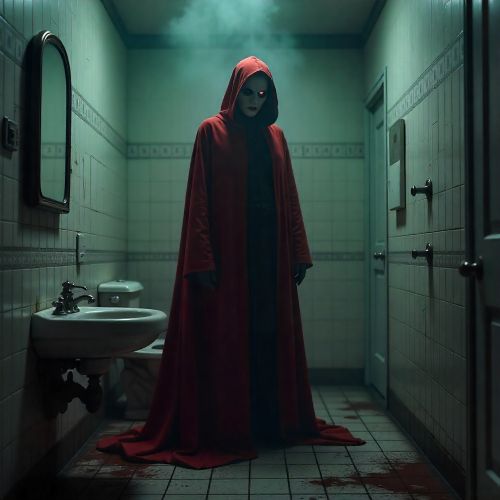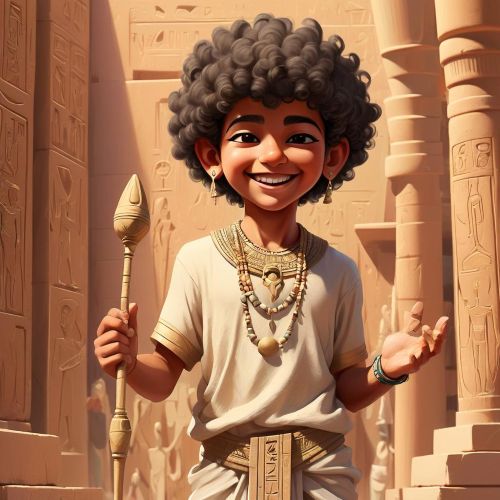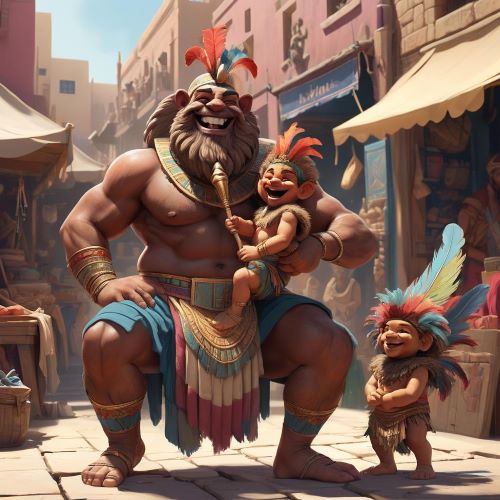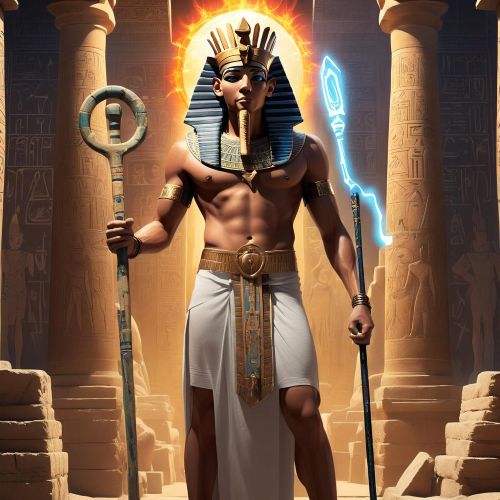Harsomtus : The Child God
Listen
At a glance
| Description | |
|---|---|
| Origin | Egyptian Mythology |
| Classification | Gods |
| Family Members | Horus (Father), Hathor (Mother) |
| Region | Egypt |
| Associated With | Sun, Rebirth |
Harsomtus
Introduction
Harsomtus, also known as Harsomptus or Somtus, is an ancient Egyptian deity who represents the powerful concept of creation, unity, and rebirth. His name originates from the Egyptian Her-Sema-Tawy, meaning “Horus who unites the Two Lands,” symbolizing both the political unification of Upper and Lower Egypt and the cosmic harmony of the universe. Though less prominent than gods like Ra or Horus, Harsomtus held deep significance in temple rituals, particularly at Dendera and Edfu, where his worship flourished during the Greco-Roman era. He was considered a manifestation of both Horus and Ra, embodying their attributes of kingship, solar energy, and renewal. Through his role as a divine child, Harsomtus personified the perpetual rebirth of the sun and the eternal cycle of creation that sustained life in ancient Egyptian cosmology.
Physical Traits
Harsomtus’s imagery is among the most visually intriguing in Egyptian art. He is most often depicted as a serpent emerging from a lotus flower—a vivid symbol of life arising from the primordial waters of Nun. This image, carved prominently in the crypts of the Temple of Hathor at Dendera, became known as the famous “Dendera Light,” representing divine energy and creation. In other portrayals, he appears as a young, naked child seated upon a lotus, embodying innocence and the dawn of existence, much like the god Harpocrates. His association with both serpent and lotus imagery emphasizes his dual nature: the serpent symbolizes wisdom, transformation, and primordial force, while the lotus signifies purity, rebirth, and the daily rising of the sun. Occasionally, Harsomtus is shown with a falcon’s head, linking him directly to Horus and the divine kingship of Egypt. This combination of serpent, lotus, and falcon iconography unites the elements of the sky, earth, and underworld, reinforcing his cosmic role as a unifier of all realms.
Family
Harsomtus’s divine lineage reflects the interconnectedness of Egyptian mythology. He is traditionally recognized as the son of Horus—particularly in his form as Heru-Behdeti, the falcon god of Edfu—and Hathor, the goddess of love, fertility, and motherhood. Together, they formed the sacred Triad of Edfu, a familial grouping similar to other divine triads across Egypt, such as Osiris, Isis, and Horus in Abydos. This structure symbolized the cyclical nature of life: father as the sustaining force, mother as the nurturer, and child as the embodiment of renewal. In certain Theban traditions during the late New Kingdom, Harsomtus was described as the son of Amun and a local manifestation of Hathor known as Hathor-Chief-of-Thebes. These variations highlight how Egyptian mythology adapted to regional worship while maintaining consistent theological themes. Harsomtus also shared strong parallels with other divine children such as Ihy, the music-playing son of Hathor, and Harpocrates, the youthful Horus, both of whom expressed the joy and vitality of rebirth.
Other names
The name Harsomtus derives from the phrase Her-Sema-Tawy, “Horus who unites the Two Lands,” a title steeped in both political and spiritual symbolism. The “Two Lands” referred to Upper and Lower Egypt, whose unification represented the harmony of opposites—order over chaos, balance over division. The Greek transliteration “Somtus” or “Harsomptus” became common during the Ptolemaic period, reflecting the blending of Egyptian and Greek religious traditions. In temple inscriptions, Harsomtus was occasionally identified with Ihy (Ahy), emphasizing his musical and celebratory aspects, particularly in Dendera where both deities were venerated. He was also called “Son of the Ground,” referencing his serpent form’s connection to the earth and fertility. At times, he appeared under the epithet Harsomtus-em-hat, a name that later inspired noble titles, such as those of priests and royal scribes, indicating the enduring reverence of his divine identity.
Powers and Abilities
Harsomtus embodied an extraordinary combination of solar, creative, and regenerative powers. In Egyptian theology, he was the divine force that emerged from the lotus at the dawn of creation, echoing the cosmic moment when light first broke through the primeval waters. This daily rebirth of the sun mirrored the god’s continual renewal and his role in maintaining Ma’at, the principle of universal balance and order. His serpent form symbolized the circulation of life energy and the cyclical rhythm of time, while his connection to Horus reinforced his attributes of kingship and protection.
As a creator god, Harsomtus was seen as the youthful form of Ra or Atum, representing the rejuvenation of divine power each morning. In some depictions, he is shown holding the sun disk, further emphasizing his solar essence. During temple rituals, priests invoked Harsomtus to ensure fertility, vitality, and protection of the land. His association with unification extended beyond geography—it symbolized the merging of cosmic dualities: day and night, chaos and order, life and death. During the New Year festivals, Harsomtus was said to merge with Horus, becoming Horus-Somtous, the eternal ruler who continually restored Egypt’s unity and divine kingship. His creative energy was not limited to myth but also reflected the Egyptians’ deep understanding of natural cycles and the spiritual power of renewal.
Modern Day Influence
In modern times, Harsomtus remains a compelling subject of fascination among Egyptologists, spiritualists, and historians of symbolism. His most recognizable depiction, the “Dendera Light,” continues to inspire debate and interpretation. Some fringe theories have claimed that the reliefs at Dendera depict ancient electrical devices; however, mainstream Egyptologists widely agree that the image represents Harsomtus’s symbolic emergence from the lotus, embodying the birth of light and cosmic energy. This misunderstanding nonetheless highlights the enduring intrigue surrounding Egyptian temple art and mythology.
The story and iconography of Harsomtus have also influenced modern art, jewelry, and literature that draw upon Egyptian themes of renewal, energy, and unity. His serpent-lotus imagery appears in contemporary designs as a metaphor for rebirth and transformation, resonating strongly with New Age and esoteric traditions. Academically, Harsomtus is studied alongside other child gods such as Harpocrates and Nefertem as part of the broader exploration of Egyptian cosmogony.
Tourists visiting the Temple of Hathor at Dendera are often captivated by the beautifully preserved reliefs depicting Harsomtus, which continue to serve as tangible connections to ancient Egyptian beliefs about life, light, and creation. His symbolism of unity—both political and cosmic—continues to echo in modern discussions about harmony between nature and humanity, reflecting how mythological archetypes can transcend time. Though lesser known than Ra or Osiris, Harsomtus endures as a reminder of the eternal power of renewal and the divine balance that sustains existence.
Related Images
Source
“Harsomtus.” Wikiwand. (2020). Retrieved from https://www.wikiwand.com/en/articles/Harsomtus
Vernus, P. (1987). Edfou, du début de la XIIe Dynastie au début de la XVIIIe Dynastie: Études philologiques, sociologiques et historiques d’un corpus documentaire de l’Égypte pharaonique (Doctoral dissertation, Sorbonne University). Available at University of Chicago – ISAC Archive.
“Harsomtus.” Wikipedia. (2002). Retrieved from https://en.wikipedia.org/wiki/Harsomtus
Alexander Ancient Art. (n.d.). Harsomtus: Horus Who Unites the Two Lands. Retrieved from https://www.alexanderancientart.com/harsomtus.php
Swarajya Magazine. (2024, October 9). Navratri Notes: Cows, Thrones, And Triune Goddesses Of Egypt. Retrieved from https://swarajyamag.com/culture/navratri-notes-cows-thrones-and-triune-goddesses-of-egypt
Ancient Egypt Tours. (n.d.). Harsomtus God of Sun Rebirth. Retrieved from https://ancientegypttours.com/harsomtus-god-of-sun-rebirth/
Helwan University. (2019). Ancient Egyptian Art and Family Relationships: Touching the Children. IAJFTH Journal, Vol. 7. Retrieved from https://tourism.helwan.edu.eg/IAJFTH/files/2019/12/Volumes-7-2019-2-2-E.pdf
Wilkinson, R. H. (2003). The Complete Gods and Goddesses of Ancient Egypt. Thames & Hudson.
Pinch, G. (2002). Handbook of Egyptian Mythology. ABC-CLIO.
Hornung, E. (1996). Conceptions of God in Ancient Egypt: The One and the Many. Cornell University Press.
Assmann, J. (2001). The Search for God in Ancient Egypt. Cornell University Press.
Teeter, E. (2011). Religion and Ritual in Ancient Egypt. Cambridge University Press.
Frequently Asked Questions
What is lorem Ipsum?
I am text block. Click edit button to change this text. Lorem ipsum dolor sit amet, consectetur adipiscing elit. Ut elit tellus, luctus nec ullamcorper mattis, pulvinar dapibus leo.
What is lorem Ipsum?
I am text block. Click edit button to change this text. Lorem ipsum dolor sit amet, consectetur adipiscing elit. Ut elit tellus, luctus nec ullamcorper mattis, pulvinar dapibus leo.
What is lorem Ipsum?
I am text block. Click edit button to change this text. Lorem ipsum dolor sit amet, consectetur adipiscing elit. Ut elit tellus, luctus nec ullamcorper mattis, pulvinar dapibus leo.
What is lorem Ipsum?
I am text block. Click edit button to change this text. Lorem ipsum dolor sit amet, consectetur adipiscing elit. Ut elit tellus, luctus nec ullamcorper mattis, pulvinar dapibus leo.
What is lorem Ipsum?
I am text block. Click edit button to change this text. Lorem ipsum dolor sit amet, consectetur adipiscing elit. Ut elit tellus, luctus nec ullamcorper mattis, pulvinar dapibus leo.


